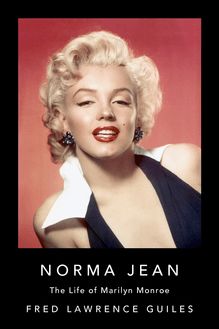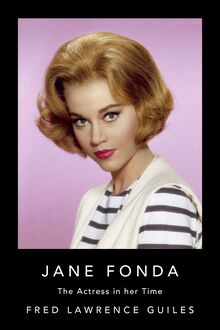Jane Fonda , livre ebook
189
pages
English
Ebooks
2020
Vous pourrez modifier la taille du texte de cet ouvrage
Obtenez un accès à la bibliothèque pour le consulter en ligne En savoir plus
Découvre YouScribe en t'inscrivant gratuitement
Découvre YouScribe en t'inscrivant gratuitement
189
pages
English
Ebooks
2020
Vous pourrez modifier la taille du texte de cet ouvrage
Obtenez un accès à la bibliothèque pour le consulter en ligne En savoir plus
Publié par
Date de parution
28 avril 2020
Nombre de lectures
0
EAN13
9781684424733
Langue
English
Poids de l'ouvrage
3 Mo
Celebrity Biographer: New York Times bestselling author Fred Lawrence Guiles is considered the premier biographer of hollywood movie stars.
Old Hollywood Charm: Lovers of classic movies and the golden age of cinema will rush to get their hands on the definitive biographies of these universally loved celebrities.
Repackaged Glam: The coordinating modern covers breathe life into these classic figures and will be a stunning addition to any hollywood-lover’s bookshelf.
Exclusive Pictures and Interviews: Each biography contain previously unpublished photographs and interviews that enhance the fascinating and nuanced lives of these famous celebrities.
Publié par
Date de parution
28 avril 2020
Nombre de lectures
0
EAN13
9781684424733
Langue
English
Poids de l'ouvrage
3 Mo
JANE FONDA
The Actress in Her Time
ALSO BY FRED LAWRENCE GUILES:
Joan Crawford: The Last Word
Norma Jean: The Life of Marilyn Monroe
Marion Davies: Hanging on in Paradise
Tyrone Power
Stan: The Life of Stan Laurel
JANE FONDA
The Actress in Her Time
FRED LAWRENCE GUILES
Turner Publishing Company
Nashville, Tennessee
www.turnerpublishing.com
Copyright 1981, 1982, 2020 Fred Lawrence Guiles
Jane Fonda
No part of this publication may be reproduced, stored in a retrieval system, or transmitted in any form or by any means, electronic, mechanical, photocopying, recording, scanning, or otherwise, except as permitted under Sections 107 or 108 of the 1976 United States Copyright Act, without either the prior written permission of the Publisher, or authorization through payment of the appropriate per-copy fee to the Copyright Clearance Center, 222 Rosewood Drive, Danvers, MA 01923, (978) 750-8400, fax (978) 750-4744. Requests to the Publisher for permission should be addressed to Turner Publishing Company, 4507 Charlotte Avenue, Suite 100, Nashville, Tennessee, (615) 255-2665, fax (615) 255-5081, E-mail: submissions@turnerpublishing.com .
Limit of Liability/Disclaimer of Warranty: While the publisher and the author have used their best efforts in preparing this book, they make no representations or warranties with respect to the accuracy or completeness of the contents of this book and specifically disclaim any implied warranties of merchantability or fitness for a particular purpose. No warranty may be created or extended by sales representatives or written sales materials. The advice and strategies contained herein may not be suitable for your situation. You should consult with a professional where appropriate. Neither the publisher nor the author shall be liable for any loss of profit or any other commercial damages, including but not limited to special, incidental, consequential, or other damages.
Cover design: Lauren Peters Collaer
Book design: Mallory Perkins
9781684424726 Paperback
9781684424719 Hardcover
Printed in the United States of America
17 18 19 20 10 9 8 7 6 5 4 3 2 1
Dedicated to the memory of Dorothy Brewster (1883-1979)
CONTENTS
Preface
PART ONE. Troubled Paradise
PART TWO. Melancholy Justified
PART THREE. Jane and the Guru
PART FOUR. Late-Blooming Flower Child
PART FIVE. Anatomy of a Failure
PART SIX. Enter Vadim
PART SEVEN. Saint Jane
PART EIGHT. No Retreat from Vietnam
PART NINE. Old friends and new Enemies
PART TEN. Rehearsal for Doomsday
PART ELEVEN. Genetic Iconography
Bibliography
Index
Don t let the things I say against myself
Betray you into taking sides against me,
Or it might get you into trouble with me.
I m not afraid to prophesy the future,
And be judged by the outcome, Meliboeus.
Listen and I will take my dearest risk.
We re always too much out or too much in.
At present from a cosmical dilation
We re so much out that the odds are against
Our ever getting inside in again.
But inside in is where we ve got to get.
My friends all know I m interpersonal.
But long before I m interpersonal
Away way down inside I m personal.
Just so before we re international
We re national and act as nationals.
R OBERT F ROST
PREFACE
You probably have to be an American to appreciate fully the current power and popularity of Jane Fonda. A series of complicated maneuvers was needed to bring her safely through the white waters of political daring, mob hatred, career blacklisting and governmental surveillance to the safe harbor of general acceptance. The constant shower of awards might be stultifying to someone other than Jane, but every Golden Globe, every Oscar, is an answer to those critics who are still vocal; the awards make her present preeminence that much more secure.
You doubtless have to be an old Hollywood hand to understand the nature and depth of her power within the industry. Jane has total control of her career: she recently got rid of her agent as superfluous; why pay a man 10 percent of your earnings when you set it all up yourself? To speak ill of Jane Fonda in the Hollywood of 1981, if you are in the studio hierarchy of any of the major studios, is to risk professional suicide. And why should you? Jane is savvy, charming, fairly original, a commanding personality but infrequently demanding, direct, loyal, courageous beyond belief, and only interested in making movies with big themes that entertain and make money. If her former prole stance was off-putting, don t knock it; Jane easily could become tomorrow s grande dame of the cinema, and does anyone really want that?
This book was written without Jane Fonda s permission or nod of approval. And yet when I had to have access to those persons in her life who witnessed severe traumas or breakthroughs the way was always clear. Divine nonintervention perhaps?
There would have been no book had I not spent several hours with director Sydney Pollack, a man as pivotal to Jane s career as John Ford was to her father s. Fortunately I had spent an equal amount of time several years ago with Actors Studio guru and one of the most influential acting teachers in the world, Lee Strasberg, so the background supplied by Pollack meshed perfectly with that supplied, in another context, by Strasberg. Through a series of doors opening up one after the other I was able to spend some time with acting teacher and director Andreas Voutsinas, who explained what Strasberg was doing for Jane.
In still another context, I managed to spend part of an afternoon in Bel Air with Jane s father, Henry Fonda. I did not yet know that I would undertake to write a book on his daughter, but those hours with Hank Fonda were invaluable to an understanding of both the man and the milieu of the Fondas, aristocrats of the film world, equally at ease in the enclaves of Benedict and Coldwater Canyons and on Cap Ferrat. My hope is that in these pages this legendary Fonda has been kept within human dimensions.
In attempting to trace the eventually tragic life of Frances Seymour Brokaw Fonda, Jane s mother, I especially want to thank her closest confidants, Eulalia Chapin and J. Watson Webb, Jr. Of Jane s stepmothers, Baronessa Afdera Fonda Franchetti has been the most helpful.
Among Jane s directors beyond Pollack I owe most to Elliot Silverstein, who filled me in on Cat Ballou and made me wonder why the work of this greatly gifted filmmaker is so infrequently seen on the screen. I am grateful, too, to Josh Logan, Alan Myerson and George Cukor for discussing Jane s talent at the beginning of her career and further along the road.
My research took me far from my Pennsylvania farm and wherever I happened to be queries about Jane Fonda brought forth instant interest and opinions. What is she up to now? someone in England inquires. I have no idea, I tell them. She is finally developing something of a mystique, and to do that successfully you cannot be always available or totally accessible. And, alas, you cannot, if you are a screen star, make too many films. Overexposure chases mystique right off the film stock of movie history.
In their various comers of the world, I wish to send my thanks to Alexander Whitelaw, Alla Peigoulevskaya, Count Rudi Crespi and Countess Consuelo Crespi, Annabella Power, David Healy, Robert J. Allen, Hope Ryden, Seymour St. John, Theodore Gostas, Mary Kling, Maryel Locke, Felizia Seyd-again for her brilliant research-and two of the finest performers anywhere, Anne Baxter and Jack Lemmon. For background on Jane s political and antiwar activities I owe much to the office of columnist Jack Anderson, especially Joseph Spear, the Department of the Army, and Jane s own writings on the subject as well as her extraordinary documentary, Introduction to the Enemy . I am grateful to John Andrew of the American Studies Department and Sidney Wise of the Government Department at Franklin and Marshall College for reading the book in manuscript and making valuable suggestions, and to Carlos MacMaster for his encouragement and support. And once again I must acknowledge my debt to the staff of the Margaret Herrick Library of the Academy of Motion Picture Arts and Science and to Paul Myers, curator of the Billy Rose Library of the Performing Arts, Lincoln Center Branch of the New York Public Library, as well as to the Helen Ganser Library staff at Millersville State College.
Fred Lawrence Guiles Lancaster County, Pennsylvania 1981
Jane Fonda: The Actress in Her Time
PART I
TROUBLED PARADISE
1
A hurricane blew north out of the tropics during the week that Henry Fonda married Frances Seymour Brokaw. It was a killer storm, but on their wedding day, September 17, 1936, most of its force had been spent and even if the day was damp nothing could have stopped Frances.
She had been a widow for a year and four months. At twenty-eight, she was a very young widow: her aging, alcoholic husband George had died of a heart attack in a Hartford sanatorium where he had gone to dry out. There was a great deal of Brokaw money, several million dollars, left in trust for their daughter Frances de Villers, known as Pan. Brokaw s first wife, Clare Boothe (later Luce), received only $425,000 in her divorce settlement back in 1929. And now Frances was marrying a movie star who was building a fortune of his own and not dissipating it. It is important to realize that our heroine, yet to be born, always knew wealth from the moment of her birth.
The Seymours were an old Canadian family, * and Frances was bom in Brockville, Ontario, in 1908. Except for one cousin, Henry Rogers, they were not known for their money, but they did have a firm base in society. Frances s father, Eugene Ford Seymour, was a part-time poet, with delicate, refined features which he passed on to his daughter. He was reserved and rather shy, but Frances was not. When one of her friends once confided to her that she had been jilted, Frances replied, When a woman re




